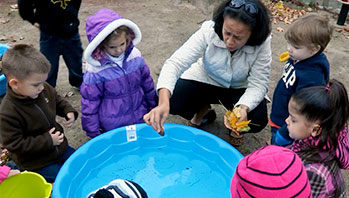- camera
- clipboard
- magnifying lenses
- paper
- pen
- community
- flower
- garden
- leaf
- plant
- root
- stem
- vegetable
MA Standards
Language/L.PK.MA.6: Use words and phrases acquired through conversations, listening to books read aloud, activities, and play.
MA Draft STE Standards
Life Sciences/From Molecules to Organisms: Inheritance and Variation of Traits/LS1/3.A: Describe/draw and compare the body parts of animals (including themselves) and plants they are investigating [System] and explain functions of some of the observable body parts. [Structure and Function]
Life Sciences/Ecosystems; Biological Evolution/LS2/4.C: Investigate local environments and infer/imagine how some living things might meet basic needs. [Structure and Function; Cause and Effect]
Head Start Outcomes
Logic and Reasoning/Reasoning and Problem Solving: Classifies, compares, and contrasts objects, events, and experiences.
Science Knowledge/Scientific Skills and Method: Observes and discusses common properties, differences, and comparisons among objects.
Science Knowledge/Scientific Skills and Method: Collects, describes, and records information through discussions, drawings, maps, and charts.
PreK Learning Guidelines:
English Language Arts/Language 2: Participate actively in discussions, listen to the ideas of others, and ask and answer relevant questions.
Science and Technology/Inquiry Skills 4: Record observations and share ideas through simple forms of representation such as drawings.
Explore Together (outdoors): Visit a Community Garden

© Commonwealth of Massachusetts, Department of Early Education and Care. All rights reserved.
STEM Key Concepts: Respect the environment and do not harm plants and other living things; Plants grow in many places; Plants exhibit diversity and variation
ELA Focus Skills: Listening and Speaking, Vocabulary
Educator Prep: Look online to find a local community garden or other garden that children can visit. Try to find a garden that includes both vegetables and flowers. Determine which area and plants are safe for children to touch before visiting. Review any guidelines with the owners of the garden so that you can relay them to children as you set up the rules for the visit.
Safety Tips:
- Remind children to wash their hands before and after the activity.
- Children’s allergies have to be taken into account before introducing them to any food items.
- Be aware of and check for poison ivy, poison sumac, thorny or prickly bushes before gathering children in a designated area.
- Remind children not to eat ANY plants or touch any plants without asking an adult.
Take children to a community garden to let them observe vegetables growing. Invite children to explore the garden, walking up the rows, touching and smelling the plants. Make sure to set rules before children explore: do not eat any plants, do not touch plants unless an adult says it is safe to touch, do not break off the leaves or flowers of plants, and treat the garden with respect.
As children are exploring, ask questions to engage them when something sparks their interest or they question something. As questions such as,
- What parts of the plants are aboveground? What parts are underground?
- What do you notice about these plants that is similar to the plants you are growing? What do you notice that is different?
- What kinds of plants do you think these are? Do you think these are vegetables or flowers? How do you know?
- How are these plants getting their needs met? How do you know?
Encourage children to look closely at the parts of each plant. Talk about how sometimes we eat the parts of the plant that grow underground (roots) and sometimes we eat the parts of the plant that grow aboveground (stems, leaves).
Take photographs and/or video children as they are exploring. Take close-up photographs and video of the plants children are focusing on to talk about later.
Reflect and Share
Once you are back to your room, ask children to share their observations with the group. Talk about the different parts of plants they observed. Use the videos and photographs to help guide discussion. Ask questions such as,
- How are the ways the plants at the garden are growing similar to the ways the plants you are growing are growing? How are they different?
- How are they similar to the plants you have explored outdoors? How are they different?
- Which plants looked ready to eat? Which ones would you like to eat? Why?
